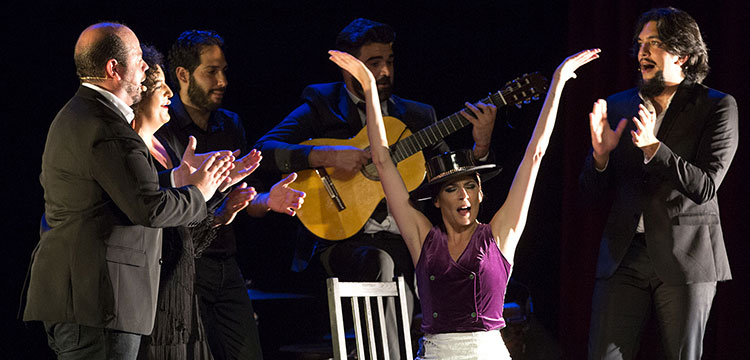Emovere. Original idea, dance and choreography: Lucía la Piñona. Artistic director: José Maldonado. Music composition and guitar: Francisco Vinuesa. Voice: Eva Ruiz ‘La Lebri’, Jonathan Reyes, Moi de Morón. Percussion: Paco Vega. Sala Chicarreros. Jueves Flamencos de Cajasol. June 28th, 2018. Full house.
Sara Arguijo
If there’s anything a theater-goer immediately notices, it’s when an artist needs to be understood. When she struggles with herself to show what she has to offer, and gives everything until there’s nothing left. Which is exactly what we saw as soon as Lucía Álvarez “La Piñona” set foot in the Cajasol theater to close out the spring season with her “Emovere”.
One way or another the dancer, winner of the first prize in dance, the Desplante, at the Festival del Cante de las Minas in 2011 and with an ample career on stage, seems to be aware of the importance of being in a series such as this, and wanted to explain her dialogue to the audience.
In this sense, as the title itself suggests, she put her experiences and emotions in movement to display her resources and her philosophy in a meticulously prepared show. Thus, despite a cold opening in which she seemed tense, and was overly stiff, the artist grew with each piece and offered interesting ideas that mark her as an original dancer, with a personality of her own. She was particularly expansive in the enthralling taranto ended with tangos, which she danced in a black latex top and fuchsia gauze skirt, and in the bulerías where she pulled up her strength and showed two of her greatest virtues: the meaning she gives to silences, and the beauty of her hands.
And we were very grateful for the excellent back-up musicians who accompanied her and without whom the work would have been completely different. Because it was here, in the delicate coherent musical composition of Francisco Vinuesa, the enriching precision of Paco Vega, the colorists, the fresh natural voices of the three singers and, needless to say, the fine wardrobe (not entirely apt, it must be said, for the segment of bulerías, petenera, soleá and and polo, nor for the specific era) and the structure itself, well-conceived and mounted, acquiring a fundamental function. Both for supporting the dancer as for leading us through the various landscapes in which the work was divided.
The sweet fine sound of La Lebri, moving in peteneras of Pastora Pavón, the fullness and good taste of Jonathan Reyes – especially good in the buleríás of Manuel Molina – and the savagery and delivery of a fine Moi de Morón, helped Lucía in her journey from the most contemplative to the most temperamental. And we liked her more and more as she liked herself.
Photo gallery by Remedios Malvarez
